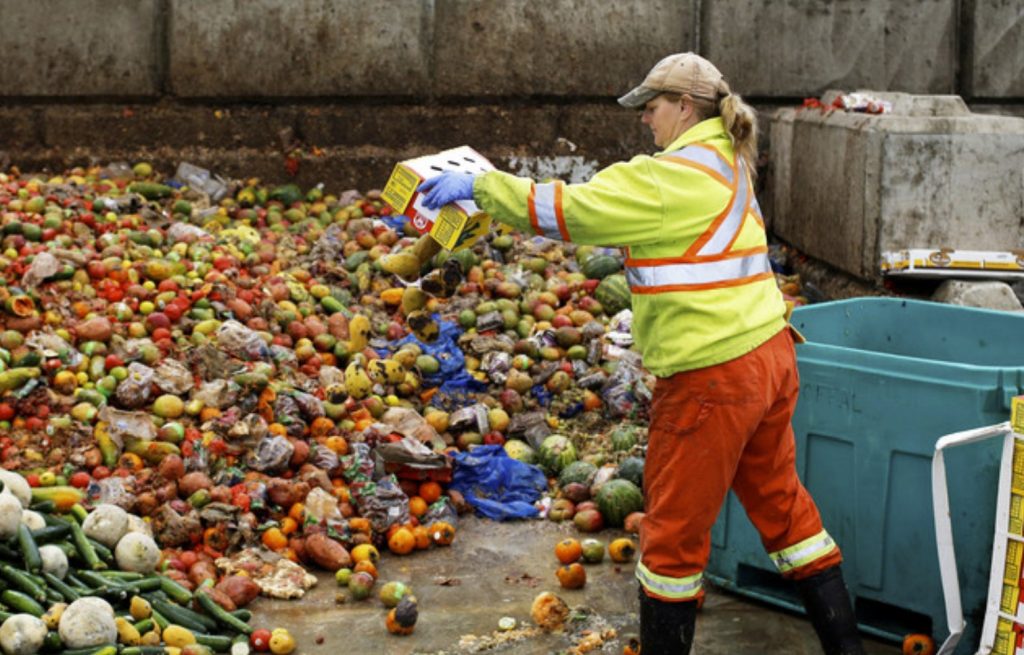Global food prices are going up, and the timing couldn’t be worse.

In Indonesia, tofu is 30% more expensive than it was in December. In Brazil, the price of local mainstay turtle beans is up 54% compared to last January. In Russia, consumers are paying 61% more for sugar than a year ago.
Emerging markets are feeling the pain of a blistering surge in raw material costs, as commodities from oil to copper and grains are driven higher by expectations for a “roaring 20s” post-pandemic economic recovery as well as ultra-loose monetary policies.
Consumers in the U.S., Canada and Europe won’t be immune either as companies — already under pressure from pandemic-related disruptions and rising transport and packaging costs — run out of ways to absorb the surge.
“People will have to get used to paying more for food,” said Sylvain Charlebois, director of the Agri-Food Analytics Lab at Dalhousie University in Canada. “It’s only going to get worse.”
While never welcome, the coming round of food inflation will be especially tough. As the pandemic wrought havoc on the global economy, it ushered in new concerns about hunger and malnutrition, even in the world’s wealthiest countries.
In the U.K., the Trussell Trust gave out a record 2,600 food parcels a day to children in the first six months of the pandemic. In the U.S., the Covid-19 crisis pushed an additional 13.2 million people into food insecurity, a 35% jump from 2018, according to estimates from Feeding America, the nation’s largest hunger-relief organization.
In the U.S., prices rose close to 3% in the year ending Jan. 2, according to NielsenIQ, roughly double the overall rate of inflation. That small jump adds up, particularly for families already near the edge. The poorest Americans already spend 36% of their income on food, according to the U.S. Department of Agriculture, and mass layoffs in lower-wage work like retail and transportation have increased the strain on household budgets.
Meanwhile, the price of staples like grains, sunflower seeds, soybeans and sugar have soared, pushing global food prices to a fresh six-year high in January. They’re not likely to fall any time soon, thanks to a combination of poor weather, increased demand and virus-mangled global supply chains.
Developed markets tend to be insulated from short-term price spikes, because food is more processed and the food chain is more elaborate. In the process of turning a bushel of corn into a bag of Tostitos, food companies have a lot of room to absorb incremental costs, said David Ubilava, a senior lecturer at the University of Sydney who specializes in agricultural economics. But when costs stay high for a sustained period of time, companies start thinking about how to pass them on.
“We are experiencing inflation right now as is everybody else,” Conagra Brands Inc. Chief Executive Officer Sean Connolly said in an interview. Costs are up for oils, pork and eggs, plus packaging materials like cardboard and steel. The company, parent to more than 70 brands including Birds Eye, Chef Boyardee, and Udi’s Gluten-Free, says raising prices is one of the levers it could pull this year to counter rising costs.
General Mills, the maker of Cheerios, Yoplait and and Blue Buffalo pet food, is also looking at price increases, said Jon Nudi, who leads the North American retail division, at least “in the areas we see significant inflation.” Dave Ciesinski, Chief Executive Officer of Lancaster Colony Corp., which makes the Marzetti brand and others, said they anticipate a sustained period of rising costs. The company is going to have to figure out how to “justifiably or appropriately pass on these costs,” he told analysts in an earnings call.
Even the cost of white label goods — also known as house brands — is likely to go up, notably in the second half of the year, said Steven Oakland, CEO of Treehouse Foods, which makes products for grocery stores to sell under their own brand names. “We’re working very closely to decide what can we mitigate,” he said. “What do we need to pass on? What’s the right movement with the consumer?”
The increases might not be immediately obvious to shoppers. Instead of raising the sticker price, retailers may cut back on multi-buy deals or special promotions. Last year, the number of grocery items sold on promotion in the U.S. dropped by 20 percentage points, according to NielsenIQ data, partly because pandemic-driven logistical challenges squeezed supply.
There may also be another round of so-called shrinkflation, where the price stays the same but the product size shrinks. That’s long been a popular tactic in the U.K., where a decade long supermarket price war has kept prices low.
A study by the Office for National Statistics found between Jan. 2012 and June 2017 — a period when food companies faced rising costs, plus a weakening pound — as many as 2,529 products were made smaller, more than four times the number that increased in size. British shoppers took special exception to the shrinking of Mars’ Maltesers by 15% and Birds Eye dropping from 12 to 10 fish fingers in a packet.
“I expect it to be a continued feature of the way that food is sold in the U.K. going forward,” Richard Lim, CEO of consultancy Retail Economics said. “I don’t think we’ll see a stop to this.”
Right now, food prices in the U.K. are flat or declining but Liliana Danila, economist at the British Retail Consortium, says she expects that to change, and it could come as a bit of a shock. A decade-long supermarket price war has accustomed British consumers to the cheapest prices in Europe. “They are maybe a bit more likely to be less prepared than consumers in other places,” Danila said.
Adding to the pressure in the U.K. is the impact of Brexit, which is adding complications and delays to previously frictionless trade. The U.K.’s Food and Drink Federation estimates that red tape and new border checks could add 3 billion pounds ($4.1 billion) in costs per year for food importers.
The food industry in North America has its own expensive challenges. In particular, a shortage of both shipping containers and truck drivers has made it more costly to transport food, and the rising price of oil has raised packaging costs.
In emerging markets, where people typically eat food closer to its natural state and prices change quickly, families are having to confront the issue right now.
“I got smaller piece of tempeh and tofu now, with the same price as last week,” said Rahayu, who goes by one name as many in Indonesia do, a 64-year-old grandmother in West Java province, noting that in recent weeks, the price of chili had more than doubled to 70,000 rupiah ($4.97) per kilogram. “I’m going to need to use less.”
With these pressures building, Russia and Argentina have put price curbs on certain staples and slapped tariffs on exports in an attempt to contain domestic food prices.
In some richer countries, governments are focusing more on self-sufficiency than price controls. France is planning to boost its output of high-protein crops to cut reliance on soybean imports, while Singapore recently became the first country to approve sales of lab-created meat as it pushes to boost its domestic food capacity.
Others are looking to broad stimulus measures. Testifying before the U.S. House Financial Services Committee last week, Federal Reserve Chair Jerome Powell pointed to food insecurity as one example of how the pandemic has strained poorer communities, and as another impetus to get the economy moving again.
“I think we’ve all been struck — how could you not be struck — by the uptake in the food area,” Powell said. “It’s a sign that support is needed and we really need to get the economy recovered as soon as possible.” [Bloomberg]
Now subscribe to this blog to get more amazing news curated just for you right in your inbox on a daily basis (here an example of our new newsletter).
You can also follow us on Facebook and/ or Twitter. And, by the way you can also make a donation through Paypal. Thank you!
You should really subscribe to QFiles. You will get very interesting information about strange events around the world.













Food is the first thing that always goes up, especially when Gas prices go up. But I’ve noticed that when the gas prices come down…the food prices always seem to say.
I grow berries and vegetables. I have livestock. I prepped 20 cases of foods last week. 6 months of survival food. I feel better now that I have more stock. I rotate through canned goods every 6 months or so.
Need another 4 cases of ramen noodles. Need another 50 lbs of rice.
*Ramen, peas, eggs, tuna, mixed in there is pretty decent. I ate it alot when I was broke. Eat small meals more frequently. Works out good for metabolism.
I pretty much seceded to the offgrid. Big cities are death zones.
WHEN the rest of the world figures out AMERICA REALLY IS THE GREAT SATAN,and its their government who is causing the food shortages world wide,THEY’LL PROBABLE DROP NUKES ON AMERICA TILL ITS NOTHING BUT ASHES,the us government has been testing Disases on Africa,TWO that will be used are EBOLA AND Hemorrhagic fever,OR THE BLEEDING DISASES,how surprised will the blind fools in america be when, BLOOD is running our of every orfic in their body,THE blind fell HOOK LINE AND SINKER FOR CV,lets see how they react to the new ones..THE WAREHOUSES AT FED-EX are over flowing with black body bags,Millions of them..I HOPE you all realize FEMA AND DHS are planning to kill all of you,and they have their own UNDERGROUND BASES to run to…